MSI K8N Neo Platinum: First nForce3-250Gb
by Wesley Fink on April 26, 2004 12:05 AM EST- Posted in
- Motherboards
BIOS: MSI K8N Neo Platinum

The K8N Neo uses Phoenix-Award BIOS, so navigation will be familiar for most users. The last few generations of MSI's top boards have promoted Core Cell overclocking, and their BIOS has sported a complete range of overclocking options.
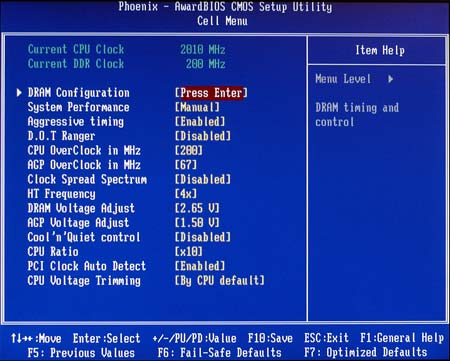
Most of the options of interest to overclockers are contained in the Cell Menu. Two easily overlooked options here are worth mentioning. "Aggressive Timings" can be enabled or disabled, and if your memory can handle it, the aggressive timings do improve performance. The other item is AMD "Cool'n'Quiet", which can be enabled or disabled here. Cool'n'Quiet is designed to protect the CPU and system from damage due to overheating and also to run the fans at the lowest and quietest speeds needed for proper operation.
Most of the commonly used adjustments are submenus under the Cell Menu.
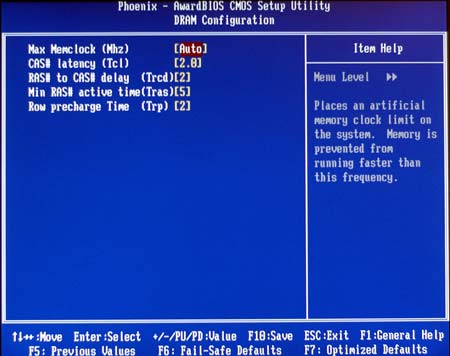
This includes a decent selection of memory timing adjustments.

MSI has the option of using an automatic overclocking system called D.O.T. for those who are intimidated by manual adjustments. The help in the BIOS and in the manual explains how it is used to provide optimized overclocks from 1% to 11%. The industry seems to think that everyone who overclocks is a gamer and 14 years old with all the cute names they use, like Sergeant and Commander on MSI and Street Racer from Abit. We personally don't like this trend, but clearly some do. The most important thing to us was that D.O.T. worked very well, and will be useful for those intimidated by the whole idea of BIOS settings. You can still reach higher overclocks with manual settings, but the D.O.T settings are well-balanced tweaks.
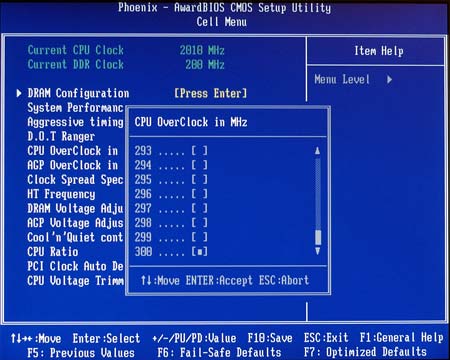
FSB can now be adjusted to 300 in the BIOS. After testing the board, a range to 350 would actually be useful on the K8N Neo - something we are finally pleased to be talking about on an Athlon 64 motherboard.
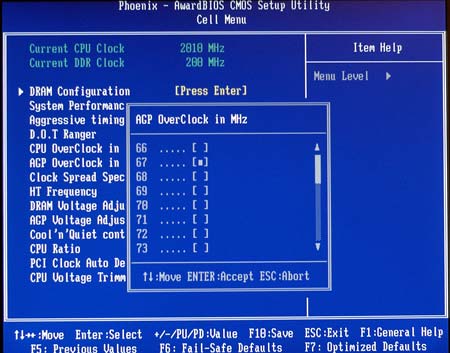
Yes, the AGP locks on the MSI K8N Neo, confirming nVidia's claim that we would see working locks on this generation. With a 300 FSB range instead of the 250 on the nVidia Reference Board, we can also confirm that the lock also works in the 250 to 300 range.

MSI uses the nF3-250Gb chipset, and therefore, offers HyperTransport adjustments to 5X (1000 HT). This is a much wider and more useful range than what we saw on the nF3-150 boards, but we do wish half multipliers had also been included. The 0.5X adjustments are very useful for getting the best performance in overclocking.

Memory Voltage can be adjusted to 2.85V, which is a useful range. Abit and Epox have provided ranges to 3.0V to 3.2V and that would be welcomed for use with the high-speed, higher-voltage memory currently on the market.

The other part of high FSB clocking is CPU ratios or multipliers. The K8N Neo provides a full range from the CPU default down to 4. We confirmed that the lower ratios do work on the MSI. Some recent boards did not work at ratios below 9, but the MSI worked at every ratio that we could select.
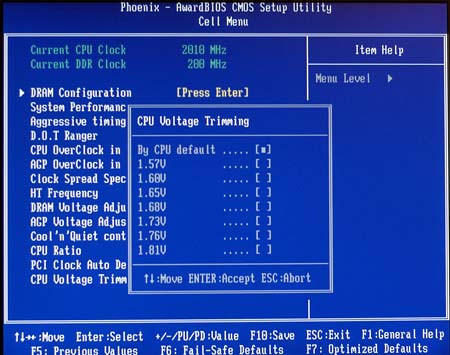
Instead of Core Voltage, MSI calls the CPU voltage adjustment "CPU Voltage Trimming". The adjustments appear to be based on percentages instead of absolute values, so they will likely shift with lower voltage CPUs. For a stock 1.5V 3400+ adjustments were available to 1.81V. This is a useful range and extends a bit beyond AMD's recommended maximum of 1.7V.
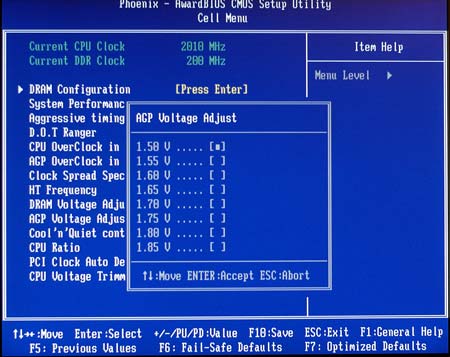
AGP voltage adjustment covers a very broad range from 1.5V to 1.85V in fine 0.05V increments. This adjustment usually makes very little difference in overclocking, but sometimes it is also the adjustment for chipset voltage, where a wide range and fine adjustments are very useful.
All of these settings are in Cell Menu, but there are many other options in the K8N Neo BIOS.
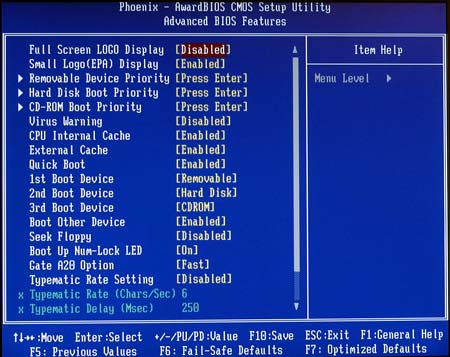
Advanced BIOS features allow control of boot devices and boot order.
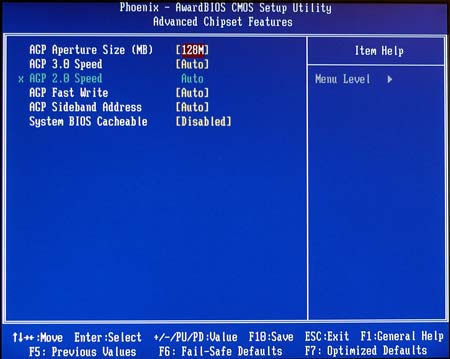
With so many of the most used adjustments under Cell Menu, the Advanced Chipset menu is mainly AGP aperture size, timings, and shadowing control.
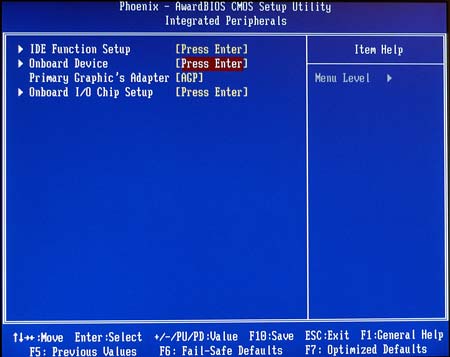
The nForce3-250Gb supports many integrated features. Most of these are controlled in the Integrated Peripherals menu.

This includes a Device submenu where setup and adjustments are made to the flexible nVidia RAID for SATA and IDE drives.
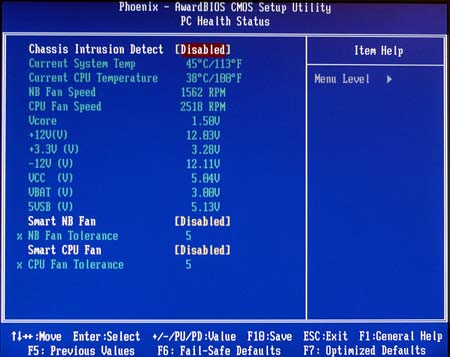
BIOS monitoring of Temperatures and Fan Speeds can be adjusted in the PC Health Menu.










26 Comments
View All Comments
Starstream - Thursday, September 16, 2004 - link
Well, I currently have an MSI board and, frankly, I would have to really have my arm twisted before I bought another. Zillions of issues with their support and documentation. I don't know...this is impressive. The "cross mount" memory slots are an interesting twist.ksherman - Sunday, August 22, 2004 - link
this is probably a dump question, but here goes:since the 3200 OCs to the level of the 3800, does that mean i am essentially (if i can reach those speeds of course) getting a 3800 in term of performance? the 3800 are clocked at 2.4GHz, and the only real difference in the processors is the clock speed correct? so a $600+ card for around $200+ seemd like a good deal to me...
Klaasman - Saturday, May 8, 2004 - link
When are these due to be available in the USA for purchase??l3ored - Saturday, May 1, 2004 - link
i'd really like to know weather the 300fsb outperformed the max oc, then i can make memory purchase decisions, perhaps a follow up review is in order?MadAd - Wednesday, April 28, 2004 - link
Raid Questions: a) I run a fasttrack tx2000 with 4 IDE drives and am wondering would I be able to use the 2 IDE channels for raid 0+1 and get a SATA to IDE converter to run an optical drive or two?b) The last raid review at AT was Jun 2001. With new provison for raid in nf250 plus older high end boards offering variations of highpoint and promise on board plus sata raid vs ide becoming a factor, wouldnt this be a good time for another one?
AtaStrumf - Tuesday, April 27, 2004 - link
Same as ATi X800Pro. Well, well don't we have a lot of 8's on the 6th. Too bad I got an exam on that very same day. Hope I get an 8 as well :)Wesley Fink - Tuesday, April 27, 2004 - link
#19 -Several nF3-250 boards are expected at Anandtech in the next couple of weeks. They are starting to show up from many manufacturers.
Also, VIA's update to the K8T800 Pro will launch on May 6.
hifisoftware - Tuesday, April 27, 2004 - link
Very, very nice review.OC bench would not hurt, but otherwise OC is very well covered.
I belive RAID was covered in the chipset review.
One thing that I would've really liked is to know when other mobos are coming out. It would seem that even without overclocking this chipset should not be slower then previous. So maybe another motherboard is gogin to be a bit faster.
mikeymasta - Tuesday, April 27, 2004 - link
Also how 'real' is the hardware raid on the nforce3?I mean can I setup a simple 2 hd based mirror raid have install FreeBSD 5.2.1 and expect it to see only 1 drive like 'true' hardware based raid or is this just software based crap that boil down to just extra IDE ports that only do so called 'raid' by software drivers?
Personally if I was in charge of making standards I would make rule #1 of the standard of raid being that you cant put the word 'raid' on your software product unless its true hardware based raid!
Bit like the true standard of PC133 ram where it couldn't be classed as 'PC133' memory unless it had a clearly printed label on it with letters 'PC133' for a start, (I remember anand pointing that out a long time ago)
AtaStrumf - Tuesday, April 27, 2004 - link
Yep, we want OC benchies!